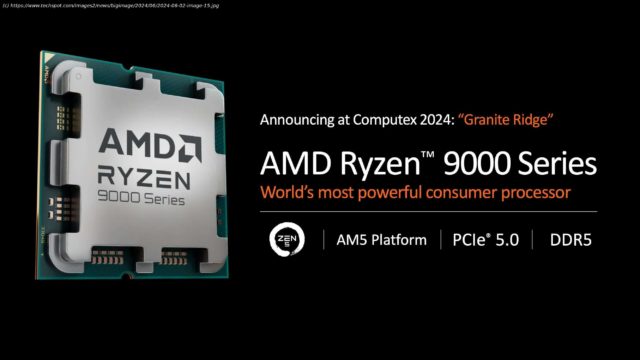It is now confirmed that AMD is jumping from the Ryzen 7000 series with Zen 4 directly to the 9000 series for Zen 5. The new CPUs,.
Highly anticipated: AMD has announced new Ryzen 9000 desktop CPUs based on the Zen 5 architecture, alongside new motherboard chipsets to support them. Additional details about the AM5 socket and new mobile chips with a heavy dose of AI were also revealed. We were briefed ahead of the Computex keynote, and are now over in Taipei, covering the floor with more coverage to come.
It is now confirmed that AMD is jumping from the Ryzen 7000 series with Zen 4 directly to the 9000 series for Zen 5. The new CPUs, codenamed Granite Ridge, are compatible with the AM5 socket, supporting DDR5 and PCIe 5.0 technologies.
While AMD hasn’t provided a deep dive on the Zen 5 architecture just yet, they made it clear that this is a major overhaul to their core design, describing it as a “sweeping update” in contrast to some previous architectures that were more iterative. Zen 5 includes significant improvements to branch prediction, wider pipelines, and deeper window sizes, with AMD claiming up to twice the instruction bandwidth, twice the data bandwidth, and twice the AVX512 throughput relative to Zen 4.
This translates into a claimed 16 percent IPC improvement for Zen 5 over Zen 4 using a geomean. This includes gains of 17% and 23% in common benchmarks like Cinebench R23 and Blender, respectively, though there will be outliers on either side. On the low end, AMD quotes 10% gains, but for specific workloads that leverage certain aspects of the new architecture (such as AVX512), those improvements could be much more substantial.
There’s been a lot of speculation around Zen 5’s IPC figures lately; we’ve seen estimates ranging from a 5% gain to some pretty outrageous claims of over 30%. So it’s good to finally get some confirmation here. This is a typical IPC gain compared to AMD’s previous architectures: Zen 4 versus Zen 3 was a 13% uplift, Zen 3 versus Zen 2 a 19% uplift, and Zen 2 was around the 15% mark over Zen 1 and Zen+. Provided AMD’s claims are accurate, this demonstrates a very consistent pace of execution with each major Zen architecture.
However, the total performance improvement from Zen 5 will be limited by clock speeds. This new generation isn’t providing significant increases in frequency based on listed specifications for each part, and core counts are identical to the Zen 4 generation. The flagship Ryzen 9 9950X is shown with a 5.7 GHz boost clock, the same as the Ryzen 9 7950X, though we don’t know how all-core clocks will fare. This suggests the majority of the performance gains will come from IPC and architectural changes.
In comparison, AMD achieved a 16 percent frequency increase with their Zen 4 flagship compared to Zen 3, which helped raise overall performance. We suspect that in typical workloads, Zen 5 will offer a smaller gain over its predecessor than Zen 4 achieved. This should be more akin to the Zen 3 versus Zen 2 improvement: that generation did not see a significant clock speed increase but did benefit from a large IPC gain.
Part of this is due to AMD using a very similar node for Zen 5 as Zen 4. AMD stated these parts are built on TSMC 4nm technology, which was used for Ryzen 8000 APUs. Ryzen 7000 CPUs with Zen 4 used TSMC’s N5 node, and both 5nm and 4nm nodes are part of the same family.
The Ryzen 9000 lineup includes all the models you would expect. There’s a 16-core Ryzen 9 9950X, a 12-core Ryzen 9 9900X, an eight-core Ryzen 9 9700X, and a six-core Ryzen 5 9600X.
We don’t have pricing for these parts yet, but they will be launched in July 2024, which is not too far away now. All include SMT and similar cache capacities to Zen 4, so the 9700X has 32MB of L3 and 8MB of L2 for a total of 40MB in cache. The 8-core and 6-core models see a 100 MHz frequency increase over their Ryzen 7000 counterparts, while the higher core count models see no frequency gain in terms of max boost.
What has been updated, though, are the TDPs, which isn’t a great indication of actual power consumption but does give some idea of how Zen 5 stacks up relative to previous models. The flagship 9950X remains a 170W part, but the 9900X drops to 120W, down from 170W previously. The 9700X and 9600X are now just 65W processors, instead of 105W previously with the 7700X and 7600X. This puts their TDPs much more in line with the non-X models, where both the 7700 and 7600 were 65W parts.
AMD isn’t making a ton of performance claims today, but did show some comparisons pitting the 9950X against the Intel Core i9-14900K. For productivity workloads, AMD is claiming notably better performance, such as a 21% gain in Cinebench R24 and a 56% gain in Blender.



![[Exclusive] itel Color Pro 5G with colour-changing back to launch in India this month](http://nhub.news/wp-content/uploads/2024/07/thumb41ac3c773a368e1d6c1b31a8254997c6-238x178.jpeg)


